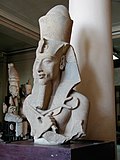New Kingdom of Egypt
The New Kingdom, is the period in ancient Egyptian history between (1570–1070 BC). During the New Kingdom Egypt was richer and more powerful than in all other periods of its history. It includes the Eighteenth, Nineteenth and Twentieth Dynasties.
Egypt expanded far south into Nubia and held wide territories in the Near East. Egyptian armies fought ancient Armenian Hittite armies for control of modern-day Syria and Egyptian territory reached its maximum extent.
Important Pharaohs
The Eighteenth Dynasty was ruled by some of Egypt's most famous Pharaohs including Akhenaten, Tutankhamun and Hatshepsut. Queen Hatshepsut concentrated on expanding Egypt's external trade and sent a commercial expedition to the land of Punt. Thutmose III ("the Napoleon of Egypt") expanded Egypt's army and created the largest empire Egypt had ever seen.
Amenhotep IV changed his name to Akhenaten in honor of the Aten. He started a religion based on one god, Aten.
Ramesses II ("the Great") of the 19th Dynasty tried to get back territories in the Levant that had been held by the 18th Dynasty. In the Battle of Kadesh he led Egyptian armies against those of the Hittite king Muwatalli II. He was caught in the first recorded military ambush, but won the battle.
Timeline

New Kingdom Of Egypt Media
Egyptian and Hittite empires, around the time of the Battle of Kadesh
Hatshepsut as a Sphinx - daughter of Thutmose I, co-regent for her two-year-old stepson Thutmose III, she soon ruled as pharaoh; Egypt prospered greatly under her rule
The Mortuary Temple of Hatshepsut at Deir el-Bahari was called Djeser-Djeseru, meaning the Holy of Holies
Thutmosis III, a military man and member of the Thutmosid royal line is commonly called the Napoleon of Egypt because his conquests of the Levant brought Egypt's territories and influence to its greatest extent
Tiye, born a commoner, became queen through her marriage to Amenhotep III and during the New Kingdom, when women gained influence in court, Tiye soon helped run affairs of state for both her husband and son during their reigns
Akhenaten, born Amenhotep IV, was the son of Queen Tiye and he turned away from the dominant cult of Amun, relocated the capitol, and promoted that of the Aten as a supreme deity
Nefertiti - the wife of Akhenaten, she held position as co-regent with Akhenaten and may have ruled later as pharaoh in her own right (as she is one of few candidates for the identity of Pharaoh Neferneferuaten)
Tutankhamun's mask - King Tutankhamun, son of Akhenaten, returned to the former capitol and restored the cult of Amun to its former influence; although he died young and was not considered significant in his own time, the 1922 discovery of his KV62 intact tomb by Howard Carter, made him relevant as a symbol of ancient Egypt to the modern world
Other websites
- New Kingdom of Egypt - Aldokkan
- Middle East on the Matrix: Egypt, The New Kingdom Archived 2003-02-26 at the Wayback Machine — Photographs of many of the historic sites dating from the New Kingdom










